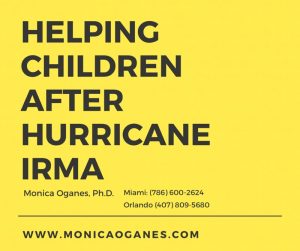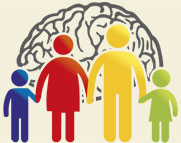Children can experience significant trauma secondary to unsettling events. As Hurricane Irma approaches, parents and teachers’ reactions to the news can be traumatic. Direct exposure could be significantly worse, causing long-lasting effects on the mental health and educational outcomes of children. Parents and teachers should make efforts to prevent mental health problems in children.
The following information was adapted from the National Association of School Psychologists:
 Natural disasters can be especially traumatic for children and youth. Experiencing a dangerous or violent storm or flood is frightening even for adults, and the devastation to the familiar environment (i.e., home and community) can be long-lasting and distressing. Often an entire community is affected, further undermining children’s sense of security and normalcy.
Natural disasters can be especially traumatic for children and youth. Experiencing a dangerous or violent storm or flood is frightening even for adults, and the devastation to the familiar environment (i.e., home and community) can be long-lasting and distressing. Often an entire community is affected, further undermining children’s sense of security and normalcy.
Children look to the significant adults in their lives for guidance on how to manage their reactions after the immediate threat is over. Parents, teachers, and other caregivers can help children and youth cope in the aftermath of a hurricane by remaining calm and reassuring children that they will be all right. Immediate response efforts should emphasize teaching and reinforcing effective coping strategies, fostering supportive relationships, and helping children understand their reactions. We are not able to prevent crises from occurring but we can control the conditions in which we work through one.
Hurricanes. Usually hurricanes are predicted days to weeks in advance, giving communities time to prepare. These predictions give families time to gather supplies and prepare, but can generate fear and anxiety about the potential impact. Severe weather events can generate damaging, fierce winds and rain. Children may re-experience startle responses, anxiety, and significant stress if they had negative experiences during a hurricane. If weather events reoccur, children may then re-experience similar stress reactions.
Tornadoes. Like earthquakes, tornadoes can bring mass destruction in a matter of minutes, and individuals typically have little time to prepare. Confusion and frustration often follow. Similar to a hurricane, people experience sensations during tornadoes that may generate coping challenges, and it can be difficult to cope with the sights and smells of destruction. Given the capricious nature of tornadoes, survivor guilt has been observed to be an especially common coping challenge. For instance, some children may express guilt that they still have a house to live in while their friend next door does not.
Floods. These events are among the most common natural disasters. Flash floods are the most dangerous as they occur without warning; move at intense speeds; and can cause extensive destruction to landscapes, roads, bridges, and buildings. Most floods do not recede overnight, and residents may have to wait days or weeks before they can begin cleanup efforts. Damp conditions within homes, shelters, and other buildings can contribute to environmental mold, which can challenge children’s and adults’ health.
——
Recovery Can Take Time
Although natural disaster events may only last a short period, survivors can be involved with the disaster aftermath and recovery for months or even years. Collaboration between the school and district crisis response teams and community, state, and federal organizations and agencies is necessary to respond to the many needs of children, families, and communities following a natural disaster. Families are often required to deal with multiple people and agencies (e.g., insurance adjustors, the Red Cross, the Federal Emergency Management Agency [FEMA], and the Salvation Army) to resolve disaster-generated problems, and they need time to do so when children are in school. Advance preparation and coordination with supporting agencies will facilitate problem solving and support family coping. Changes brought about by disaster experiences create a “new normal” for survivors.
Possible Reactions of Children and Youth
The severity of children’s reactions will depend on their specific risk factors. These include exposure to the actual event, personal injury or loss of a loved one, level of parental support, displacement from their home or community, the level of physical destruction, and pre-existing risks, such as a previous traumatic experience or mental illness. Adults should contact a professional if children exhibit significant changes in behavior or any of the following symptoms over an extended period of time (more than 6 months).
- Preschoolers—thumb sucking, bedwetting, clinging to parents, sleep disturbances, loss of appetite, fear of the dark, regression in behavior, and withdrawal from friends and routines.
- Elementary school children—irritability, aggressiveness, clinginess, nightmares, school avoidance, poor concentration, and withdrawal from activities and friends.
- Adolescents—sleeping and eating disturbances, agitation, increase in conflicts, physical complaints, delinquent behavior, and poor concentration.
A minority of children may be at risk of posttraumatic stress disorder (PTSD). Symptoms can include those listed above, as well as re-experiencing the disaster during play and/or dreams, anticipating or feeling that the disaster is happening again, avoiding reminders of the disaster, general numbness to emotional topics, and increased arousal symptoms, such as inability to concentrate and startle reactions. Although rare, some adolescents may also be at increased risk of suicide if they suffer from serious mental health problems like PTSD or depression. Adults should seek professional mental health help for children exhibiting these symptoms.
Immediately Following a Natural Disaster: Information for Parents and Teachers
Remain calm and reassuring. Children take their cues from adults, especially young children. Acknowledge the loss or destruction, but emphasize the community’s efforts to clean up and rebuild. To the extent it is possible to do so, assure them that family and friends will take care of them and that life will return to normal.
Acknowledge and normalize their feelings. Allow children to discuss their feelings and concerns, and address any questions they may have regarding the event. Listen, empathize, and let their questions be the guide. An empathetic listener is very important. Let them know that their reactions are normal and expected.
Encourage children to talk about disaster-related events. Children need an opportunity to discuss their experiences in a safe, accepting environment. Provide activities that enable children to process their experiences. This may include a range of methods (both verbal and nonverbal) and incorporate varying projects (e.g., drawing, stories, music, drama, audio and video recording). Seek the help of the school psychologist, counselor, or social worker if you need help with ideas to open the dialogue.
Promote positive coping and problem-solving skills. Activities should teach children how to apply problem-solving skills to disaster-related stressors. Encourage children to develop realistic and positive methods of coping that increase their ability to manage their anxiety and to identify which strategies fit with each situation.
Emphasize children’s resiliency. Focus on their competencies. Help children identify what they have done in the past that helped them cope when they were frightened or upset. Bring their attention to other communities that have experienced natural disasters and recovered (e.g., New Orleans, LA, or Joplin, MO).
Strengthen children’s friendship and peer support. Children with strong emotional support from others are better able to cope with adversity. Children’s relationships with peers can provide suggestions for how to cope and can help decrease isolation. In many disaster situations, friendships may be disrupted because of family relocations. In some cases, parents may be less available to provide support to their children because of their own distress and feelings of being overwhelmed. Activities such as asking children to work cooperatively in small groups can help children strengthen supportive relationships with their peers.
Take care of your own needs. Take time for yourself and try to deal with your own reactions to the situation as fully as possible. You will be better able to help your children if you are coping well. If you are anxious or upset, your children are more likely to feel the same way. Talk to other adults such as family, friends, faith leaders, or counselors. It is important not to dwell on your fears or anxiety by yourself. Sharing feelings with others often makes people feel more connected and secure. Take care of your physical health. Make time, however small, to do things you enjoy. Avoid using drugs or alcohol to feel better.
Immediately Following a Natural Disaster: Specific Information for Schools
Identify children and youth who are high-risk and plan interventions. Risk factors are outlined in the above section on children’s reactions. Interventions may include classroom discussions, individual counseling, small-group counseling, or family therapy. From classroom discussions, and by maintaining close contact with teachers and parents, the school crisis response team can help determine which students need counseling services. A mechanism also needs to be in place for self-referral and parent referral of students.
Provide time for students to discuss the disaster. Depending on the situation, teachers may be able to guide this discussion in class, or students can meet with the school psychologist or other mental health professional for a group crisis intervention. Classroom discussions help children to make some sense of the disaster. They also encourage students to develop effective means of coping, discover that their classmates share similar questions, and develop peer support networks. Teachers should not be expected to conduct such discussions if children are severely affected or if they are distressed themselves. A crisis team member should be made available to facilitate the discussion.
Allow time for staff to discuss their feelings and share their experiences. Members of your crisis team should also have the opportunity to receive support from a trained mental health professional. Providing crisis intervention is emotionally draining, and caregivers will need an opportunity to process their own crisis responses. Caregivers could include teachers and other school staff if they have been serving as crisis caregivers for students.
Secure additional mental health support. Although many caregivers are often willing to provide support during the immediate aftermath of a natural disaster, long-term services may be lacking. School mental health professionals can help provide and coordinate mental health services, but it is important to connect with community resources as well in order to provide such long-term assistance. Ideally, these relationships would be established in advance.
Helping Children Adjust to Relocation After a Natural Disaster
The frequent need to relocate after a disaster creates unique coping challenges. It may contribute to the social, environmental, and psychological stress experienced by children and their families. Children will be most affected by the reactions of their parents and other family members, the duration of the relocation, their natural coping styles and emotional reactivity, and their ability to stay connected with friends and other familiar people and activities. To the extent possible, parents and other caregivers should:
- Provide opportunities for children to see friends.
- Bring personal items that the child values when staying in temporary housing.
- Establish some daily routines so that the child is able to have a sense of what to expect (including returning to school as soon as possible).
- Provide opportunities for children to share their ideas, and listen carefully to their concerns or fears.
- Be sensitive to the disruption that relocation may cause, and be responsive to the child’s needs.
- Consider the developmental level and unique experiences of each child; it is important to remember that as children vary, so will their responses to the disruption of relocation.
In addition, school personnel should:
- If possible, determine the status of every child in the school, particularly those who have not returned after the disaster incident. Develop an outreach strategy for children who are displaced and living in shelters or temporary housing.
- Identify ways for students to stay in contact with displaced classmates.
- Utilize an advisory committee of students to help identify ways that students might prioritize positive school activities in order to help them regain a sense of normalcy.
- Permit survivors to retell their stories in a safe environment that avoids vicarious traumatization. Provide opportunities for children to discuss how they are coping. Use creative arts (e.g., drama, art, music, photography) to help them express their emotions.
- Help connect families to community resources, and maintain current contacts with disaster-related support services. Provide information to parents about available physical and behavioral healthcare services, and if possible, help provide child care while they are meeting with agencies.
- Anticipate the need for increased before- and after-school child care, and explore options to provide that service.
- Incorporate information about the disaster into related subject areas, as appropriate. Science, math, history, and language arts are especially relevant.
Please do not hesitate to contact us in Miami or Orlando if your child is experiencing symptoms of trauma. We are here to help.
For hurricane-related information in Florida, contact the Florida Division of Emergency Management.
Credit: National Association of School Psychologists. (2015). Helping children after a natural disaster: Information for families and educators [handout]. Bethesda, MD: Author.



